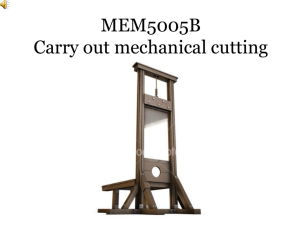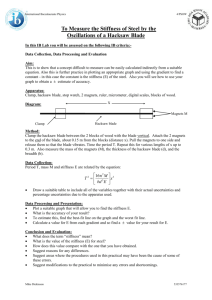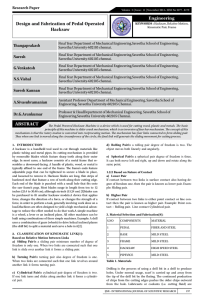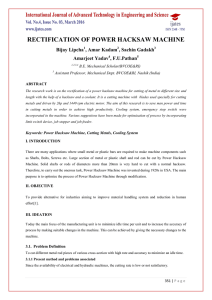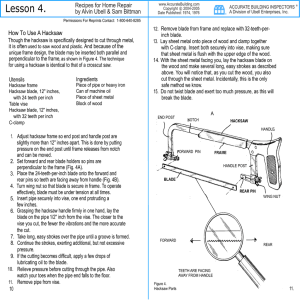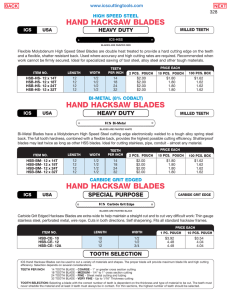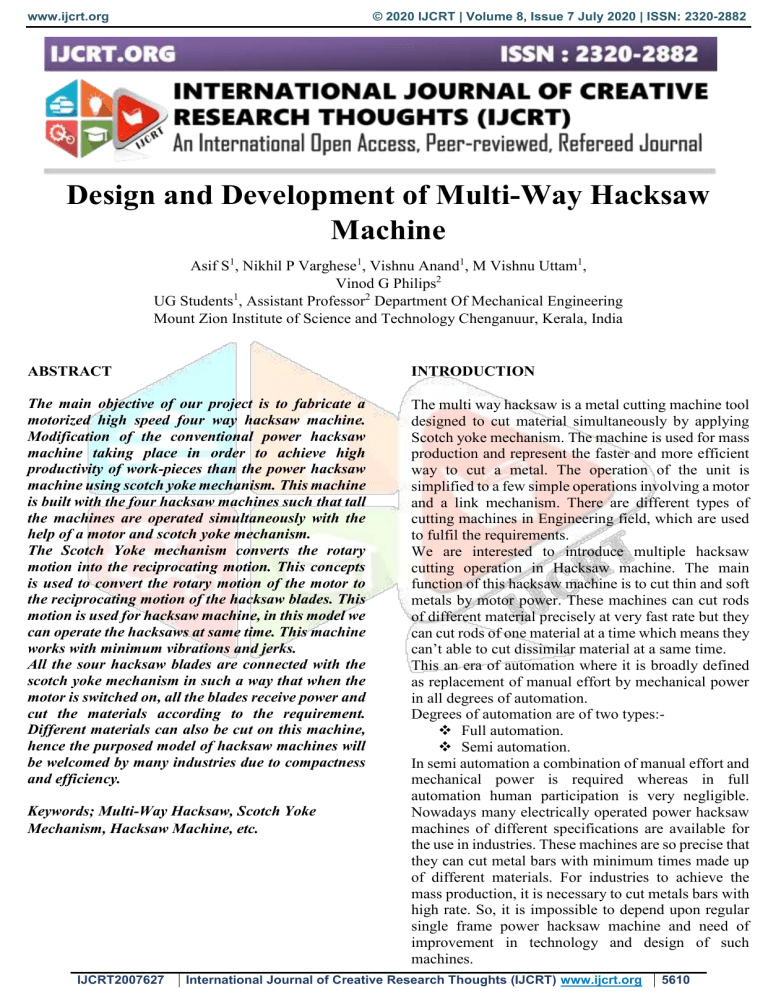
www.ijcrt.org © 2020 IJCRT | Volume 8, Issue 7 July 2020 | ISSN: 2320-2882 Design and Development of Multi-Way Hacksaw Machine Asif S1, Nikhil P Varghese1, Vishnu Anand1, M Vishnu Uttam1, Vinod G Philips2 UG Students1, Assistant Professor2 Department Of Mechanical Engineering Mount Zion Institute of Science and Technology Chenganuur, Kerala, India ABSTRACT INTRODUCTION The main objective of our project is to fabricate a motorized high speed four way hacksaw machine. Modification of the conventional power hacksaw machine taking place in order to achieve high productivity of work-pieces than the power hacksaw machine using scotch yoke mechanism. This machine is built with the four hacksaw machines such that tall the machines are operated simultaneously with the help of a motor and scotch yoke mechanism. The Scotch Yoke mechanism converts the rotary motion into the reciprocating motion. This concepts is used to convert the rotary motion of the motor to the reciprocating motion of the hacksaw blades. This motion is used for hacksaw machine, in this model we can operate the hacksaws at same time. This machine works with minimum vibrations and jerks. All the sour hacksaw blades are connected with the scotch yoke mechanism in such a way that when the motor is switched on, all the blades receive power and cut the materials according to the requirement. Different materials can also be cut on this machine, hence the purposed model of hacksaw machines will be welcomed by many industries due to compactness and efficiency. The multi way hacksaw is a metal cutting machine tool designed to cut material simultaneously by applying Scotch yoke mechanism. The machine is used for mass production and represent the faster and more efficient way to cut a metal. The operation of the unit is simplified to a few simple operations involving a motor and a link mechanism. There are different types of cutting machines in Engineering field, which are used to fulfil the requirements. We are interested to introduce multiple hacksaw cutting operation in Hacksaw machine. The main function of this hacksaw machine is to cut thin and soft metals by motor power. These machines can cut rods of different material precisely at very fast rate but they can cut rods of one material at a time which means they can’t able to cut dissimilar material at a same time. This an era of automation where it is broadly defined as replacement of manual effort by mechanical power in all degrees of automation. Degrees of automation are of two types: Full automation. Semi automation. In semi automation a combination of manual effort and mechanical power is required whereas in full automation human participation is very negligible. Nowadays many electrically operated power hacksaw machines of different specifications are available for the use in industries. These machines are so precise that they can cut metal bars with minimum times made up of different materials. For industries to achieve the mass production, it is necessary to cut metals bars with high rate. So, it is impossible to depend upon regular single frame power hacksaw machine and need of improvement in technology and design of such machines. Keywords; Multi-Way Hacksaw, Scotch Yoke Mechanism, Hacksaw Machine, etc. IJCRT2007627 International Journal of Creative Research Thoughts (IJCRT) www.ijcrt.org 5610 www.ijcrt.org © 2020 IJCRT | Volume 8, Issue 7 July 2020 | ISSN: 2320-2882 With the help of this multi way power hacksaw machine materials can be cut simultaneously to get high cutting rate and to achieve mass production for maximum profit in related company. As this machine overcomes all the limitations and drawbacks of regular hacksaw machines, it is also helpful for small scale industries due to its simple, easy working and operating conditions along with its compatibility, efficiency and affordable price. The setup of machine is very simple, it operates with mechanism of eccentric cam disc arrangement. Disc is rotated with AC motor, rotary motion of wheel is converted into the reciprocating motion of the cutting tool (hacksaw). This reciprocating motion is used to obtain the linear motion of blades and material is cut. The size and shape of this setup is small. Work holding jaw is provided for placing the work piece to be cut. A low power AC motor is required for its operation. Length of crank and connecting rod is selected using trial and error method. Motion of hack saw is guided by guiding rods placed over the hack saw frame. The vertically downward motion is occurred due to self-weight of frame, so it can be called as gravity feed hack saw. LITERATURE REVIEW The problem of cutting-off material to size is common to practically every industry. Often, sawing is the first operation carried out on bar stock. Therefore, it is surprising that so little work has been done to understand the problems of this common operation. Many reasons have been given for this such as lack of interest, it is a routine operation and that there is no need to consider better methods. Often the foreman will assign a new trainee to a sawing task, on the principle that it is easy to learn and difficult to foul up. Furthermore cut-off machines are frequently housed in stores away from the main production areas and the operation of the sawing machines appears to be simple. The fact remains that cutting-off operations can account for a significant part of the cost per piece (Remmerswaa and Mathysen, 1961). The reason for carrying out the present work is the growing realization on the part of manufacturers of both blades and machines, that the factors which control the mechanics and economics of power hacksawing are complex. Also power hacksawing has been receiving increased competition from other cutting off processes, such as band and circular sawing. Whilst the British Standard BS 1919: 1974 gives specifications for hacksaw blades regarding dimensions etc. the standard relates to testing of hacksaw blades for hand use only and does not include power hacksaw blade testing. IJCRT2007627 Thus, both manufacturers of hacksaw blades and users have experienced considerable difficulty in establishing standard testing procedures and in obtaining consistency in test data using power hacksaw machines. Preliminary investigations by the author have revealed that existing blade testing methods were not independent of the machine characteristics, which could contribute to one of the reasons for the inconsistency in the test data. Hence, there has been requirement to identify the machine characteristics under normal working conditions and to investigate the mechanics of the sawing process and the variables affecting metal removal rate. Most of the early published work on cutting-off has been primarily concerned with circular and band sawing and cost comparisons between alternative processes. Whilst these alternative processes are frequently, quicker than power hacksawing, their costs are in many applications higher. Whilst the impact of these alternative processes on the application of power hacksawing cannot be denied there remains a significant field of application for power hacksawing which is likely to remain unchallenged. A factor of prime interest to manufacturers is that, if the costs of power hacksawing can be reduced by developing the blade and the saw machine, the potential field of application will be widened. During the past fifty years very little attention has been devoted to developing the geometry of the hacksaw blade or the machine, although, some improvements in the blade material, together with methods of applying the load and mechanized work handling, have been achieved (Nelson,1965). R.S. Khurmi, J.K. Gupta in their book -Theory of machines‖ (Velocities in mechanisms) helps to find Velocity diagrams of slider crank mechanism. Prof. Nitinchandra R. Patel, Ravi Thakkar, Miteshkumar Rathwa in his research paper -Material selection and testing of hacksaw blade based on mechanical properties‖ stated that the appropriate saw blade must be selected for better operation and fine cutting by selecting number of teeth per inch. D.V. Sabarinanda, V. Siddhartha, T. Mohanraj in their paper- Design and Fabrication of Automated Hacksaw Machine‖ (April 2014) gives an idea about the various components required for fabrication of the proposed model. These components will help to get smooth working condition and future automation of different mechanical actions as well as linkages. K. Prashant, (2015) explained in their paper that, there are many electrically operated power hacksaw machines of different configurations and different manufacturers are available for the use in machine shop. This study gives guidelines about selection of material for our model in present situation the hydraulically and electrically operated hack saw machines are available International Journal of Creative Research Thoughts (IJCRT) www.ijcrt.org 5611 www.ijcrt.org © 2020 IJCRT | Volume 8, Issue 7 July 2020 | ISSN: 2320-2882 but these are require more input as compared to output i.e. it does not gives satisfactory output. Also it can be able to cut only one component at a time a machine cuts four rods at a time gives improved productivity. As PDH uses a slider crank mechanism but we are going to use eccentric cam for obtain reciprocating motion. H G Chothani, (2015) explained, in Mechanical Workshop/Technical institute, designer always faces the difficulties to select the perfect hack saw blade material for use of trainee as well as students to avoid accidents and reduce failure rates of blade. Hence when the motor is switched on, the power from the motor is delivered to the cam wheel. The cam wheel rotates such that the hack saw blades reciprocate. The work pieces are mounted on the machine vice firmly and the entire system is switched on. Thus the four workpieces are cut simultaneously using the motor and the Scotch Yoke Mechanism. SYSTEM ARCHITECTURE It is found to drive the roller shaft which fixed on the end of the frame structure. The free end of the shaft in the motor a large pulley is found around which the belt runs. The other specification about the motor is discussed in design part of the machine. Specifications: Single Phase, 220v, 0.25 HP, 1440rpm, Grinder Motor. This model consists of a frame on which the hacksaw blades are mounted. The hacksaw blades are mounted on the four sides of the frame. The circular cam plate is mounted in the centre of the frame which is operated by a motor. The power to the motor is given with the help of an AC supply. Connecting rods are used to connect the cam wheel and the hacksaw blades. The cam mechanism is used to convert the rotary motion into the reciprocating motion. Hence when the motor is switched on, the power from the motor is delivered to the cam wheel. The cam wheel rotates such that the hack saw blades reciprocate. The work pieces are mounted on the machine vice firmly and the entire system is switched on. Thus the four work pieces are cut simultaneously using the motor and the Scotch Yoke mechanism. COMPONENT DETAILS AC MOTOR Design Calculation Velocity Calculation; Considering cutting stroke length, l = 228.6mm Radius, r = 114.3mm Length of the connecting rod, L1= 482.6mm Angular velocity, ω = (2πN) ÷ 60 = 9.42 rad/sec Fig. Hacksaw Machine WORKING PRINCIPLE The experimental setup of our project consists of a frame on which the hacksaw blades are mounted. The hacksaw blades are mounted on the four sides of the frame. The circular cam plate is mounted in the center of the frame which is operated by a motor. The power to the motor is given with the help of an AC supply. Connecting rods are used to connect the cam wheel and the hacksaw blades. Scotch Yoke mechanism is one of reciprocating motion mechanism, it should be convert a rotary motion into sliding of linear motion. IJCRT2007627 Fig 3.5 Velocity Diagram Crank radius, OP = 114.3mm OA=OB=OC=OD= Connecting rod length Velocity of P is, VP = OP X ω International Journal of Creative Research Thoughts (IJCRT) www.ijcrt.org 5612 www.ijcrt.org © 2020 IJCRT | Volume 8, Issue 7 July 2020 | ISSN: 2320-2882 = 0.1143 X 9.42 = 1.076 m/sec From velocity Diagram converting the linear motion of a slider into rotational motion, or vice versa. The piston or other reciprocating part is directly coupled to a sliding yoke with a slot that engages a pin on the rotating part. VAP=VBP=VCP=VDP = 0.0965 Nm/sec Torque Available, Power output = T X ω = (482.6 X .0967) X 4 = 186.42 Nm/sec Neglecting losses power is equal to power output 186.42 = T X ω T = 186.42 ÷ 9.42 = 19.78 Nm Power, This is made of mild steel material. The whole parts are mounted on this frame structure with the suitable arrangement. Boring of bearing sizes and open bores done in one setting so as to align the bearings properly while assembling. Provisions are made to cover the bearings with grease. Design Calculation of Base Frame P = (2πNTA) ÷ 60 Base frame safety design M/I = σb/y ------------------------------------------ (1) Bending Moment, M = force X perpendicular distance = ma X perpendicular distance = 30.5 X 9.81 X 750 = 224403.75Nmm Moment of Inertia, I = bh3/12 = (25 X 253)/12 = 32552.08 mm4 Y = 25/2 = 12.5mm TA = 186.42 ÷ 9.42 = 19.78 Nm So Available, Torque TA, = 19.78 Nm Power P = 186.42 W Speed N = 90rpm BEARINGS Therefore Bending stress, The bearings are pressed smoothly to fit into the shafts because if hammered the bearing may develop cracks. Bearing is made up of steel material. Bearing Dimensions Bearing Number Bore Diameter, Outside Diameter, Width, Fillet Radius Weight Static Load Rating Extended Dynamic Load FRAME σb = (224403.75 X 12.5)/32552.08 = 86.17Nmm ≤ 105 Therefore design is Safe Design Calculation of Disc M/I = σb/y ------------------------------------------- (1) = 204W d = 20mm D = 47mm C = 14mm = 1mm = 0.113kg Co = 9300 N CE = 19500 N SCOTCH YOKE MECHANISM The Scotch Yoke (also known as slotted link mechanism) is a reciprocating motion mechanism, IJCRT2007627 Fig 3.15 Disc International Journal of Creative Research Thoughts (IJCRT) www.ijcrt.org 5613 www.ijcrt.org © 2020 IJCRT | Volume 8, Issue 7 July 2020 | ISSN: 2320-2882 Bending Moment, M = force X perpendicular distance = ma X perpendicular distance = 10 X 114.3 X 9.81 = 11212.83Nmm Moment of Inertia for Circular Disc I = MR2/4 = (11212.83 X 52)/4 = 70080 mm4 Bending stress σb = (11212.83 X 114.3)/70080 = 18.28Nmm ≤ 105 Therefore the design is Safe. MACHINE VICE A vice is a mechanical apparatus used to secure an object to allow work to be performed on it. Vises have two parallel jaws, one fixed and the other movable, threaded in and out by a screw and lever. SHAFT A shaft is a rotating machine element which is used to transmit power from one place to another. The power is delivered to the shaft by some tangential force and the resultant torque (or twisting moment) set up within the shaft permits the power to be transferred to various machines linked up to the shaft. In order to transfer the power from one shaft to another, the various members such as pulleys, gears etc., are mounted on it. ADVANTAGES Simple in construction. Easy to fabricate. The components used for the fabrication are easily available. Repairing and replacing of motor is not a difficult task. Multiple work pieces can be cut simultaneously. The time taken for cutting operation is less. Increased productivity. The involvement of manual work is very negligible. No need of skilled operators to operate this machine. CONCLUSION A strong multi-discipline team with a good engineering base is necessary for the Development and refinement of advanced computer programming, editing techniques, diagnostic Software, algorithms for the dynamic exchange of informational different levels of manufacturing work. We conclude that the purposed machine will aim in the limitations of single piece cutting of material at the instant of time by introducing four way cutting of material simultaneously. It is so compact that will be occupy less space, cost effective so usable in mini and large industries. As in cutting it take less time of cutting per unit of work piece, so machine idle time is also reduced which also encounters on improved efficiency, reliability. It also works on minimizing vibrations and jerks produced during cutting operation. This project work has provided us an excellent opportunity and experience, to use our limited knowledge. We gained a lot of practical knowledge regarding, planning, purchasing, assembling and machining while doing this project work. We feel that the project work is a good solution to bridge the gates between the institution and the industries. We are proud that we have completed the work with the limited time successfully. The “MULTI- WAY HACKSAW MACHINE” is working with satisfactory conditions. We can able to understand the difficulties in maintaining the tolerances and also the quality. We have done to our ability and skill making maximum use of available facilities. In conclusion remarks of our project work, let us add a few more lines about our impression project work. Thus we have developed a “MOTORIZED HIGH SPEED FOUR WAY HACK SAW MACHINE” which helps to increase the productivity by enhancing the cutting operation with the help of four hacksaw machines operated by a motor simultaneously. By using more techniques, they can be modified and developed according to the applications. FUTURE SCOPE APPLICATIONS These types of motorized high speed four way hack saw machines have a wide range of applications in the fields like, IJCRT2007627 In all industries. Small scale industries. All manufacturing plants. Highly suitable for production industries and workshops. The machine can be fully automated by using Micro-controller. In fully automated machine the operator need not measure the length of the work piece. International Journal of Creative Research Thoughts (IJCRT) www.ijcrt.org 5614 www.ijcrt.org © 2020 IJCRT | Volume 8, Issue 7 July 2020 | ISSN: 2320-2882 The inputs can be given by the operator with the help of a keypad and LCD display. Automatic lifting up mechanism for frame when cutting operation is finished to introduce next potion of bar for cutting. REFERENCE 1) Prof. Kshirsagar Prashant R, ―Theoretical Analysis of Multi-Way Power Hacksaw Machine,‖ International Journal of Research in Advent Technology, Vol.3, No.4, April 2015 E-ISSN: 2321-9637 2) Rishi Anand, Khomesh, Shrawan Kumar, Prof. Alok Verma,‖ Theoretical Analysis Of Four Way Hacksaw Blade Machine, International Journal of Advance Research and Innovative Ideas in Education, ISSN(O)-2395-4396, Vol-2 ,Issue-2 ,April2016 3) Prof. Nitinchandra R. Patel, Mohammad A. Vasanwala, Balkrushna B. Jani, Miteshkumar D. Rathwa, Ravi A. Thakkar, Material Selection and Testing of Hacksaw Blade Based on Mechanical properties‖, International Journal of Innovative Research in Science, Engineering and Technology, ISSN: 23198753, volume 2, Issue6, June 2013. 4) D. V. Sabarinanda, V. Siddhartha, B. Sushil Krishnana, T. Mohanraj, ―Design and Fabrication of Automated Hacksaw Machine, International Journal of Innovative Research in Science, Engineering and Technology, ISSN (Online):2319-8753, volume 3, April 2014. 5) Rakesh Ambade, Amit Sartabe, Meghraj Arekar, Vaibhav Khachane, Prajakta Gawali , Design & Fabrication of Human Powered Multi-Purpose Machine, International Journal of Advanced Technology in Engineering and Science, ISSN(Online):2348-7550,Volume No 03,Special Issue No.01,April 2015. 6) [6] H G Chothani, B B Kuchhadiya, J R Solanki, ―Selection of Material for Hacksaw Blade using AHP-PROMETHEE Approach‖, International Journal of Innovative Research in Advanced Engineering (IJIRAE) ISSN: 23492163 Volume 2 Issue 1 (January 2015). IJCRT2007627 International Journal of Creative Research Thoughts (IJCRT) www.ijcrt.org 5615
